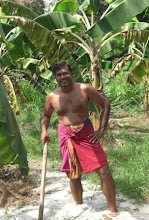
December 26th saw the birth of a male calf, to the heifer I took in my pick up from Godagama a few years back. Females are desired for future milk. He looks the spitting image of his dad, who was also taken from Godagama, and was the first calf born since my return to SL at the end of 2004, and a few days before the Tsunami. As the father could not be called Tsunami, the son can and maybe one day the father and son could used to pull a cart to take people around the farm!
One must realize that the male calves have no other future than ending up at some stage at the hands of a butcher’s knife. However pious people try and prevent animal slaughter, but money creeps in and meat is the result. The male I brought to Polonnaruwa has so far avoided the fate because the Friesen look that he has, which is black and white has involved him in being used to impregnate the local heifers. I have not made any charge for that service as I am sure he has calmed down as he feels his needs are met often. As bulls are hard to control, their noses are often pierced and a rope is put through which is used to control them.
The birth was in heavy rain, and the special hut prepared for them, was abandoned due to the rain even seeping in there. It is important that we take the excess milk after the calf has had its share, as these special types are bred for milk and it is important that this milk is extracted as otherwise the output will fall with future pregnancies.
The problem now is with the excessive rain it has been difficult to find grass to feed them, and all the available land is cultivated with rice paddies. In an ideal scenario, the grass would be cut and taken to a cattle shed where the steer manure can be collected in one place to be used to make compost. To be fair for a farmer the ability to make maximum use of the manure is just as, if not more important than the milk. The high yielding grasses unfortunately don’t grow here.
One problem has been to isolate the animals in one place. The coconut seedlings and other vegetation doesn’t get unnecessarily eaten up in the process. It is a perennial problem of farmers that stray cattle destroy other people’s crops as they are not properly tied up. I have lost many a coconut plant to cattle, as the people responsible for taking care of them have been derelict in not controlling their movement. With an organized plan to isolate the areas of their habitation, I hope to be able to increase the herd and also provide the basic raw material for compost which will be an essential ingredient in the growth of crops in a future with no subsidized fertilizer. It is important that we start now.


2 comments:
how about some updated photos of this new birth on the land?
you can do a then/now contrast
c7n85t2g11 v8j78b6e63 f4j64m7v35 a1p37n6f59 y7v63e6l18 f0v98u2k13
Post a Comment